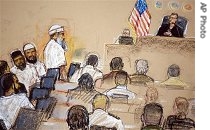VOA标准英语2008年-Five Suspects on Trial at Guantanamo for 9/11 A(在线收听)
By Al Pessin
Guantanamo Bay, Cuba
05 June 2008
Five men who were allegedly involved in planning and financing the September 11 attacks on the United States in 2001 went on trial before a military commission Thursday near the detention center where they are held on the U.S. Naval Base at Guantanamo Bay, Cuba. VOA's Al Pessin is there and filed this report.
 |
| A sketch by courtroom artist Janet Hamlin, reviewed by the US military, showing four of the Sept. 11 attacks co-conspirator suspects, Guantanamo Bay US Naval Base, Cuba, 05 June 2008 |
The alleged mastermind of the September 11 attacks, Khalid Sheikh Mohammed, chanted from the Koran, called the process an "Inquisition," and indicated he intends to plead guilty to the charges against him and hopes to be executed. He also said he was tortured while in custody during the last five years and told the military judge he does not want a lawyer to represent him.
Those were among the highlights of Thursday morning's court session, in which the U.S. government formally presented charges of conspiracy in the murder of nearly 3,000 people in the attacks in Washington and New York, and the crash of a hijacked airliner in Pennsylvania. At a closed hearing last year to determine his official status, Khalid Sheikh Mohammed said he is in fact responsible for the attacks, and was involved in a series of other terrorist activities during the last two decades.
This was the first time these men have been seen by anyone outside the U.S. military since they were captured. All wore traditional white Arab-style robes and most had head coverings. Mohammed appeared with black-rimmed glasses and a long, bushy gray beard. Only one, Ramzi Bin Al-Shibh, wore leg irons and was shackled to the floor.
Officials say the detainees were required to attend this arraignment, but will be allowed to stay away from later stages of their trial if they want.
Reporters and human rights activists were allowed to watch and hear the session, with a 20-second audio delay, but no recording or picture-taking was allowed. Sketches by an artist will be distributed.
The detainees took the opportunity of being together to engage in a series of animated conversations up and down the row where they sat at the side of the courtroom, sometimes smiling and even laughing.
In this hearing, the defendants are being told about the charges, which could result in execution, and their rights to be represented by military and civilian attorneys. They are also expected to be given the chance to plead innocent or guilty.
The military judge, Colonel Ralph Kohlman, allowed the defendants to speak freely, but ordered their lawyers to sit down several times when he believed they were speaking out of turn. During the morning, he did not exercise his prerogative to cut off the audio and video feed from the courtroom, which he or a security officer can do if anyone discloses secret information.
One human rights activist observing the hearing called it "dispiriting." The activists, as well as lawyers for both sides, will offer more extensive readouts of the hearing later in the day.
This military commissions process, created specially for suspects in the war on terror, is highly controversial. The U.S. Supreme Court struck down the original plan, and is now considering a case that could invalidate the current, revised process.